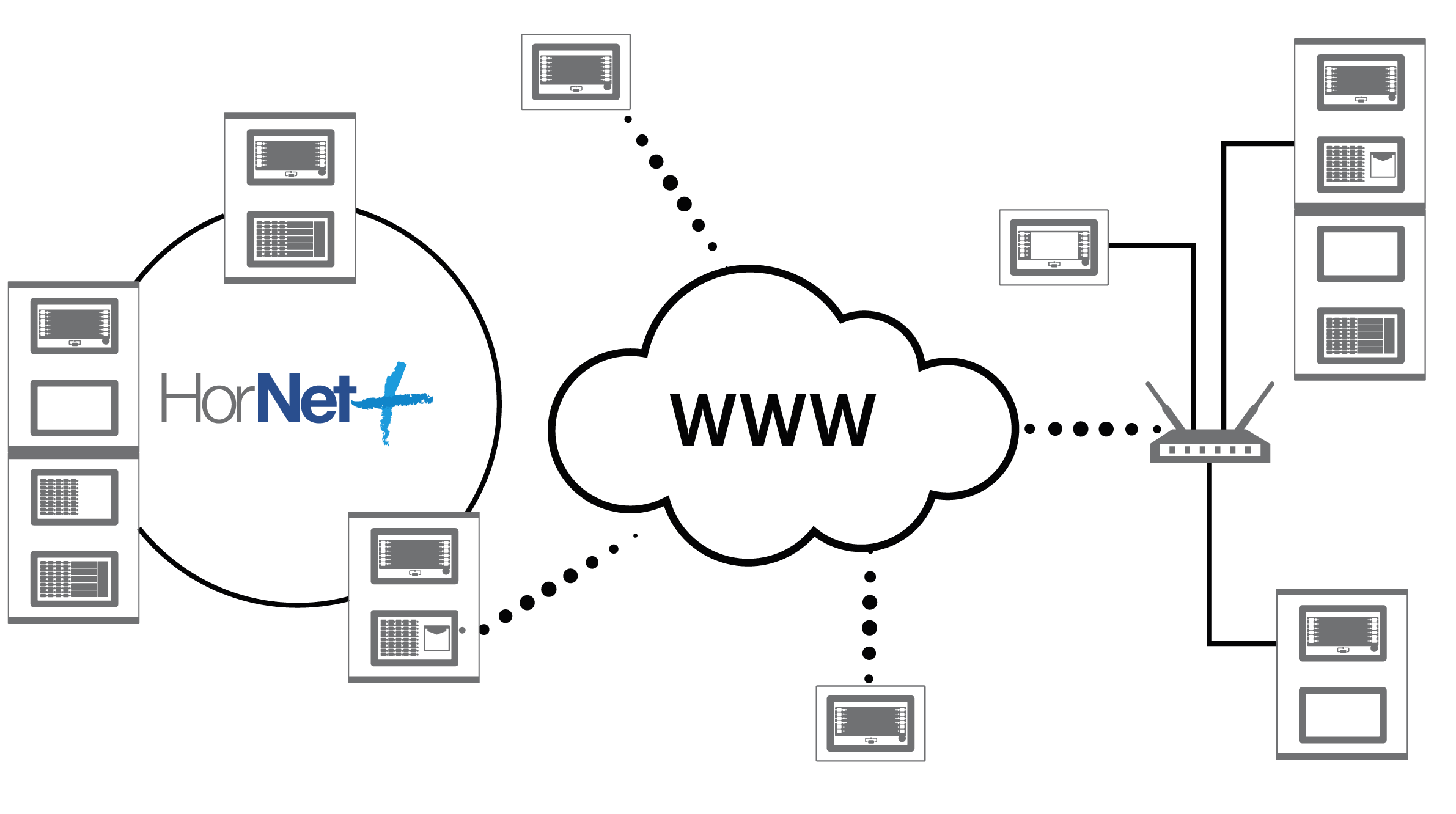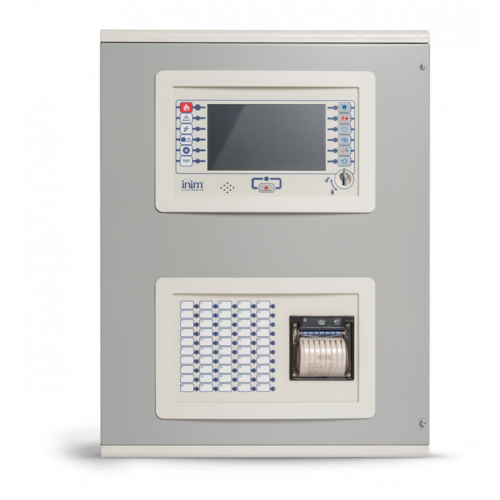
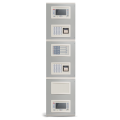
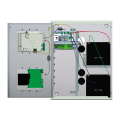
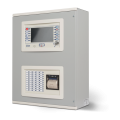
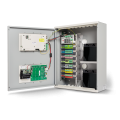
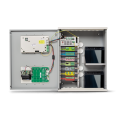
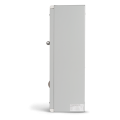
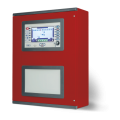
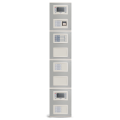

Previdia216
Analogue addressable control panel with networking capability for automatic fire detection and alarm signalling systems
Previdia Max is a modular system for the realization of fire detection and extinguishment systems.
Previdia Max control panels can comprise a single cabinet or several cabinets (max. 4) assembled together.
The control panels can be used individually or interconnected in a network, the network connection can be achieved through an RS485 BUS, via a TCP-IP connection or by means of a combination of both.
Configuration of the base control panel:
Metal cabinet
- N°1 FPMCPU module - control unit with display
- N°1 IFM24160 – 4A power-supply modules with built-in battery charger
- N°1 IFM2L – 2 loop management module
PREVIDIA216R : As Previdia216 but comes in red cabinet.
Multi-cabinet control panels
Several cabinets (Max. 4) can be joined together in order to form an increased-sized cabinet and expand the capacity of a control panel.
The cabinets can be assembled together using the supplied mounting screws and once assembled the CAN drive bars can be connected together by means of the suppled wire. The assembled cabinets provide respective number of housings for the frontplate and CAN drive bar modules. Each cabinet can house a IFM24160 power-supply module.
A control panel with more than one IFM24160 power-supply module is capable of managing a current equal to the sum of the maximum currents of its power-supply modules. The power-supply modules will share the load current automatically.
In automated detection and fire extinguishing systems, in view of their essential role in public safety and, of course, all mandatory requirements, certifications are an essential aspect. That is why the Previdia Max system has obtained all the necessary certificates from the most prestigious European institute in the field of fire prevention: LPCB.
Additionally, to provide peace of mind to installers, system designers and end-users, the certificates were obtained in compliance with all applicable standards:
EN54-2 |
Control and signalling equipment. |
EN54-4 |
Power supply equipment. |
EN54-21 |
Alarm transmission and remote fault and warning signalling equipment. |
EN12094-1 |
Components for gas extinguishing systems - automatic electrical devices for extinction and delay commands and management. |
EN54-13 (certification in progress) |
Compatibility of the components of a system. |
This means that in addition to the standard certifications required for a fire detection system, Previdia Max has obtained even further certification - related functions and exclusive features - uncommon in the fire security sector, thus placing it in the highest position in the market.
The evolution of fire detection systems
- Highly simplified
Thanks to its graphic colour touchscreen, Previdia Max simplifies configuration, management and maintenance of the system and makes almost effortless what was until today time consuming and complicated.
- Highly intuitive
Thanks to innovative concepts such as the graphic-map feature which provides instant location of danger, and video verification that uses IP cameras to provide real-time images of the exact point of an alarm, Previdia Max drastically reduces response times during moments of real danger and greatly reduces the false alarm rate.
- Highly flexible
Thanks to its modular architecture, Previdia Max offers a system that is suitable for all types of installations, from small business premises to large airports, hotels and shopping malls. The use of completely functional modules offers optimized protection to the electronic components and allows the addition of those specific functions installations so often require. Each control panel can be made up of a minimum of one cabinet to a maximum as four and is capable of managing up to 32 IFM modules.
- Highly intelligent
Thanks to a distributed-intelligence structure which uses a microprocessor inside each module, redundant microprocessors in the main unit and the possibility of having a backup CPU, Previdia Max guarantees unmatched reliability. The security of the system is no longer entrusted to a single processing unit but to a group of interconnected CPUs which operate in synergy to provide the fastest and most effective response.
- Highly articulated
Thanks to its powerful network architecture, Previdia Max allows the realization of hybrid systems based on connections using bights, fiber optics and TCP-IP networks capable of overcoming all barriers and of reaching unprecedented cover. Each cluster of control panels interconnected through a Hornet+ network can support up to 48 control panels, and up to 20 clusters can be connected through a TCP/IP network.
- Highly robust
Thanks to HOT SWAP technology modules can be added or replaced without shutting down the system, thus providing Previdia Max with a fast, safe method of intervention without any services interruptions.
- Highly reliable
Thanks to loop control modules equipped with “power up boosters”, Previdia Max allows you to set the operating voltage of each separate cable thus ensuring reliability and wiring simplicity.
- Highly multimedial
Thanks to the intensive use of new technologies such as the Web Server, electronic mail, TCP-IP connections, telephone and GSM communications, Previdia Max provides a system that is always under control and in reach. Both for the end-user and maintenance personnel.
Central on single wardrobe
If the Previdia Max system consists of a single cabinet with a primary CPU unit (crucial for system functioning), it will be possible to install on front door a second module, selected from the following list.
FPMNUL | Plastic support with no functions. |
FPMLED | Signalling module with 50 individually programmable tri-colour LEDs. |
FPMLEDPRN | Signalling module with 50 individually programmable tri-colour LEDs and an 80mm printer. |
FPMEXT | Extinguishment channel status module, to be used when the control panel is equipped with IFMEXT modules for the management of automatic extinguishment systems. |
FPMCPU | CPU module (identical to the primary unit) configured as a secondary CPU unit. In the event of fault on the primary CPU unit it will take over thus making 100% of the functions on the primary CPU redundant. |
The cabinet has a CAN drive for the interconnection of a maximum of 8 IFM modules. In accordance with the needs of the system, the following modules are available.
IFM24160 (Max 4) | Power supply module. |
IFM2L (Max 8) | Module for the management of two ring circuits for devices distributed in the protected area, commonly referred to as a LOOP. |
IFM4R (Max 16) | 4 Programmable relay module. |
IFM4IO (Max 16) | 4 supervised power Input/Output module. |
IFMDIAL (Max 1) | PSTN and GSM line dialler module. |
IFM16IO (Max 4) | Module 16 inputs/outputs at low power. |
IFMNET (Max 1) | Control panel to Hornet+ network connection module. |
IFMLAN (Max 1) | Advanced TCP-IP service management module (Video verification, Web Interface Web, electronic mail etc.) |
IFMEXT (Max 24) | Gas extinguishment-system management module. |
The first position at the top of the CAN drive bar is for the IFM24160 power supply module (essential for the proper functioning of the control panel). The remaining 7 connectors can be used for the connection of any of previously mentioned modules (the maximum number at the side of each module refers to applications with several cabinets).
Control panel in a Hornet network+
The system can be expanded by simply connecting other control panels (maximum 48) in such a way as to constitute a system with increased capacity (Hornet+ network). In order to connect two or more control panels in a Hornet+ network, it is necessary to install an IFMNET module in each control panel, this module provides two RS485 ports for the ring connection.
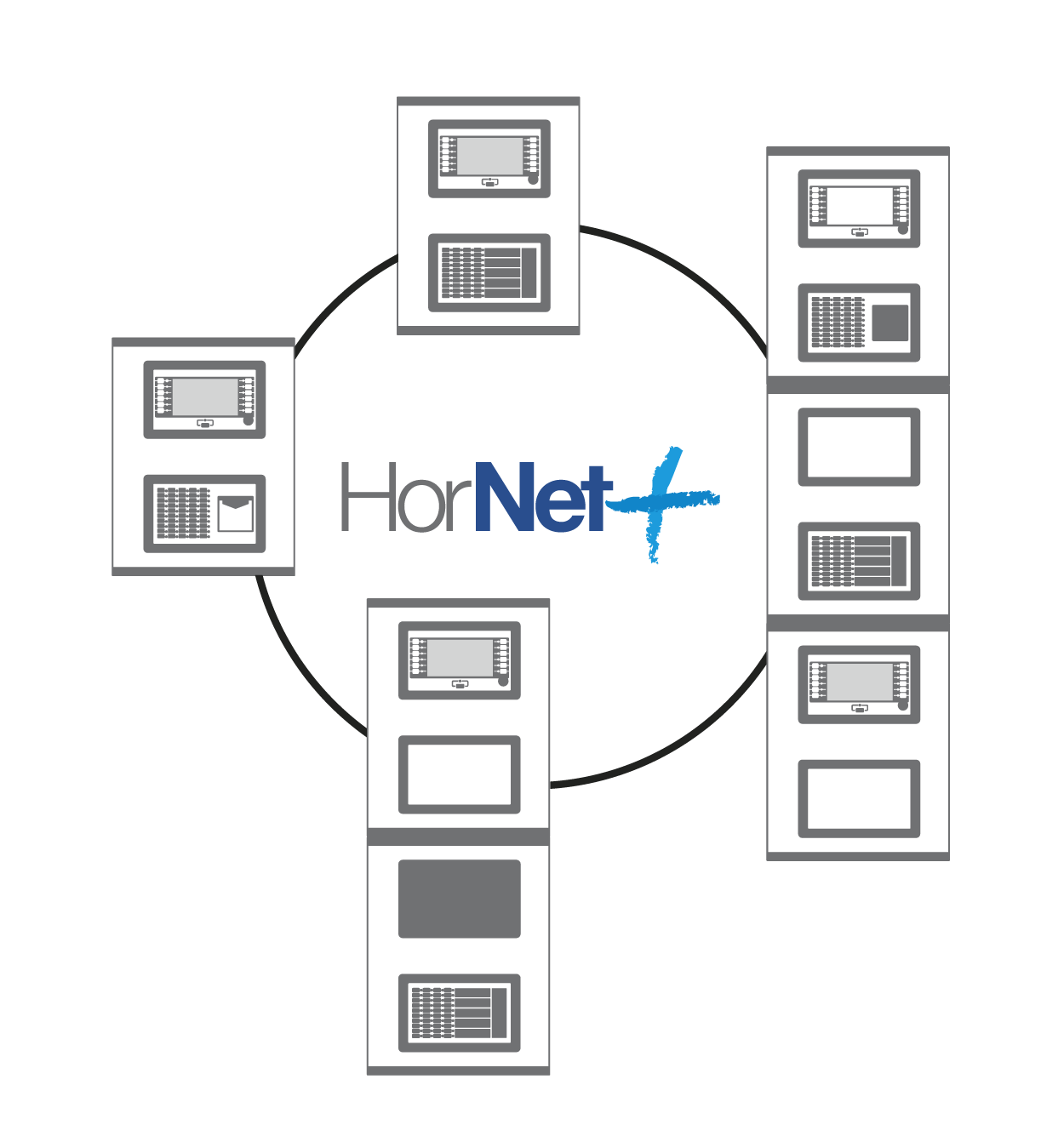
Control Panels in an IP network
Several control panels or Hornet+ networks of control panels can be connected together by means of a TCP-IP connection. Each node of such a connection type is identified as a “Cluster”; each “Cluster” can be made up of a single control panel, a Hornet+ network of control panels or a Repeater (FPM-CPU unit configured as a remote keypad).
